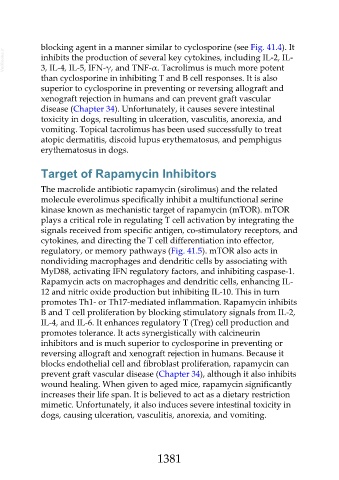Page 1381 - Veterinary Immunology, 10th Edition
P. 1381
blocking agent in a manner similar to cyclosporine (see Fig. 41.4). It
VetBooks.ir inhibits the production of several key cytokines, including IL-2, IL-
3, IL-4, IL-5, IFN-γ, and TNF-α. Tacrolimus is much more potent
than cyclosporine in inhibiting T and B cell responses. It is also
superior to cyclosporine in preventing or reversing allograft and
xenograft rejection in humans and can prevent graft vascular
disease (Chapter 34). Unfortunately, it causes severe intestinal
toxicity in dogs, resulting in ulceration, vasculitis, anorexia, and
vomiting. Topical tacrolimus has been used successfully to treat
atopic dermatitis, discoid lupus erythematosus, and pemphigus
erythematosus in dogs.
Target of Rapamycin Inhibitors
The macrolide antibiotic rapamycin (sirolimus) and the related
molecule everolimus specifically inhibit a multifunctional serine
kinase known as mechanistic target of rapamycin (mTOR). mTOR
plays a critical role in regulating T cell activation by integrating the
signals received from specific antigen, co-stimulatory receptors, and
cytokines, and directing the T cell differentiation into effector,
regulatory, or memory pathways (Fig. 41.5). mTOR also acts in
nondividing macrophages and dendritic cells by associating with
MyD88, activating IFN regulatory factors, and inhibiting caspase-1.
Rapamycin acts on macrophages and dendritic cells, enhancing IL-
12 and nitric oxide production but inhibiting IL-10. This in turn
promotes Th1- or Th17-mediated inflammation. Rapamycin inhibits
B and T cell proliferation by blocking stimulatory signals from IL-2,
IL-4, and IL-6. It enhances regulatory T (Treg) cell production and
promotes tolerance. It acts synergistically with calcineurin
inhibitors and is much superior to cyclosporine in preventing or
reversing allograft and xenograft rejection in humans. Because it
blocks endothelial cell and fibroblast proliferation, rapamycin can
prevent graft vascular disease (Chapter 34), although it also inhibits
wound healing. When given to aged mice, rapamycin significantly
increases their life span. It is believed to act as a dietary restriction
mimetic. Unfortunately, it also induces severe intestinal toxicity in
dogs, causing ulceration, vasculitis, anorexia, and vomiting.
1381

